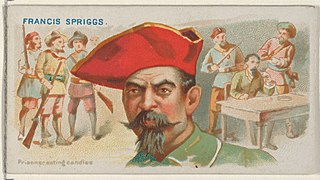
Jolly Roger is the traditional English name for the flags flown to identify a pirate ship preceding or during an attack, during the early 18th century.

Bartholomew Roberts, born John Roberts, was a Welsh pirate who was, measured by vessels captured, the most successful pirate of the Golden Age of Piracy. During his piratical career, he took over 470 prize ships. Roberts raided ships off the Americas and the West African coast between 1719 and 1722; he is also noted for creating his own pirate code, and adopting an early variant of the Skull and Crossbones flag.

Thomas Tew, also known as the Rhode Island Pirate, was a 17th-century English privateer-turned-pirate. He embarked on two major pirate voyages and met a bloody death on the second, and he pioneered the route which became known as the Pirate Round. Other infamous pirates in his path included Henry Every and William Kidd.
James Plaintain was a pirate active in the Indian Ocean. He is best known for using his pirate wealth to found a short-lived kingdom on Madagascar.
John Taylor was a pirate active in the Indian Ocean, best known for participating in two of the richest pirate captures of all time.

Edward England was an Irish pirate. The ships he sailed on included the Pearl and later the Fancy, for which England exchanged the Pearl in 1720. His flag was the classic Jolly Roger — almost exactly as the one "Black Sam" Bellamy used — with a human skull above two crossed bones on a black background. Like Bellamy, England was known for his kindness and compassion as a leader, unlike many other pirates of the time.

Edward "Ned" Low was a notorious pirate of English origin during the latter days of the Golden Age of Piracy, in the early 18th century. Low was born into poverty in Westminster, London, and was a thief from an early age. He moved to Boston, Massachusetts, as a young man. His wife died in childbirth in late 1719. Two years later, he became a pirate, operating off the coasts of New England and the Azores, and in the Caribbean.

George Lowther was an English pirate who, although little is known of his life, was reportedly active in the Caribbean and Atlantic during the early 18th century. His First Mate was Edward Low.
Christopher Moody (1650s-1722) was a pirate as a member of Bartholomew Roberts' crew but was never a captain in his own right. He is best known not for his own actions but for a popular Jolly Roger flag mis-attributed to him as well as for later authors confusing him with unrelated pirate William Moody.

Emanuel Wynn was a French pirate of the 17th century who is often considered the first pirate to fly the Jolly Roger.

Francis Spriggs was a British pirate who, associated with George Lowther and Edward Low, was active in the Caribbean and the Bay of Honduras during the early 1720s.

John Phillips was an English pirate captain. He started his piratical career in 1721 under Thomas Anstis, and stole his own pirate vessel in 1723. He died in a surprise attack by his own prisoners. He is noted for the articles of his ship, the Revenge, one of only a few complete sets of pirate articles to survive from the so-called Golden Age of Piracy.

The capture of the sloop Ranger was a naval battle which occurred on June 10, 1723 near Block Island in the Atlantic Ocean. Two pirate ships under the command of Englishmen Edward Low and Charles Harris attacked HMS Greyhound, a post ship of the British Royal Navy which they mistook for a civilian whaler. The resulting engagement lasted for several hours and ended with Harris' sloop Ranger being captured by Greyhound while Low's schooner Fancy escaped. All surviving crew of Ranger were captured and brought to Newport, Rhode Island, where they were placed on trial, sentenced to death and executed.

The Battle of Cape Lopez was fought in early 1722 during the Golden Age of Piracy. A Royal Navy ship of the line under the command of Captain Chaloner Ogle defeated the pirate ship of Bartholomew Roberts off the coast of Gabon, West Africa.
Richard Shipton was a pirate active in the Caribbean, best known for sailing alongside Edward Low and Francis Spriggs. In 1723 Shipton was elected captain of Merry Christmas, and he subsequently captained ships such as Royal Fortune, York, and John and Mary. Forced to beach his vessel on western Cuba by pirate hunters, in early 1726, he was found ashore in his bed and presumed to have died shortly afterwards.

Philip Lyne was a pirate known for his cruelty and his association with Francis Spriggs.
William Mayes was a pirate active in the Indian Ocean. He was best known for taking over William Kidd’s ship Blessed William and sailing with Henry Avery.
William Read was a pirate active in the Indian Ocean near Madagascar. He is best known for rescuing fellow pirate captains John Bowen and Thomas White.
Evan Jones was a Welsh-born pirate from New York active in the Indian Ocean, best known for his indirect connection to Robert Culliford and for capturing a future Mayor of New York.

John Russell was a pirate active from Nova Scotia to the Caribbean to the African coast. He is best known for his association with Edward Low and Francis Spriggs, and for his involvement with two well-known and well-documented maroonings.















